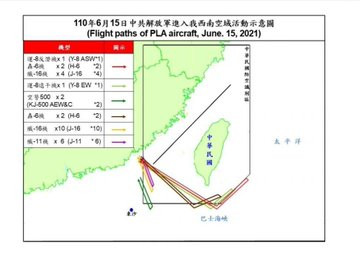

Taipei, June 15 (CNA) As many as 28 Chinese military aircraft, including fighter jets, entered Taiwan's air defense identification zone (ADIZ) on Tuesday, two days after the Group of Seven (G7) highlighted the importance of peace and stability across the Taiwan Strait.
According to a report from Taiwan's Ministry of National Defense (MND), the Chinese aircraft involved included one Y-8 anti-submarine warfare plane, one Y-8 electric warfare aircraft, four H-6 bombers, two KJ-500 airborne early warning and control planes, six J-11 multi-role fighters and 14 J-16 multi-role fighters from the People's Liberation Army (PLA).
The sorties were the most reported in a single day by the MND since it began making public PLA incursions near Taiwan last September.
While some PLA aircraft limited themselves to the airspace between Taiwan and the Taiwan-controlled Dongsha-Islands, some took a half-circle and flew to the southeastern side of Taiwan, which is also part of Taiwan's ADIZ, a chart provided by the MND showed.
Taiwan's Air Force responded by scrambling planes to monitor the Chinese aircraft, issuing radio warnings and mobilizing air defense assets until the Chinese planes left the area, the MND said.
The show of force came two days after the G7 issued a communique following a summit, underscoring the importance of peace and stability across the Taiwan Strait, and encouraging the peaceful resolution of cross-strait issues.
Taipei considers the G7 leaders' statement to represent "resolute support" for Taiwan, which Beijing claims as part of its territory.
Former Defense Minister Andrew Yang (楊念祖) told CNA that Beijing's show of force could be aimed at showing off the ability of the PLA to carry out joint maneuvers, at the same time sending a signal to the international community that China will not back off on issues relating to national sovereignty.
Su Tzu-yun (蘇紫雲), a senior analyst at the government-funded Institute for National Defense and Security Research (INDSR), told CNA that the PLA's maneuvers could be an attempt to mollify hawkish groups and nationalists in Beijing at a time when many countries are increasingly finding China's "wolf warrior diplomacy" distasteful and see the Chinese Communist Party as a systemic challenge.